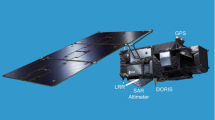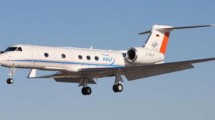Abstract
An airborne radio occultation (RO) system has been developed to retrieve atmospheric profiles of refractivity, moisture, and temperature. The long-term objective of such a system is deployment on commercial aircraft to increase the quantity of moisture observations in flight corridors in order to improve weather forecast accuracy. However, there are several factors important to operational feasibility that have an impact on the accuracy of the airborne RO results. We investigate the effects of different types of navigation system noise on the precision of the retrieved atmospheric profiles using recordings from the GNSS Instrument System for Multistatic and Occultation Sensing (GISMOS) test flights, which used an Applanix POS/AV 510 Global Positioning System (GPS)/Inertial Navigation System (INS). The data were processed using a carrier phase differential GPS technique, and then the GPS position and inertial measurement unit data were combined in a loosely coupled integrated inertial navigation solution. This study quantifies the velocity precision as a function of distance from GPS reference network sites, the velocity precision with or without an inertial measurement unit, the impact of the quality of the inertial measurement unit, and the compromise in precision resulting from the use of real-time autonomous GPS positioning. We find that using reference stations with baseline lengths of up to 760 km from the survey area has a negligible impact on the retrieved refractivity precision. We also find that only a small bias (less than 0.5% in refractivity) results from the use of an autonomous GPS solution rather than a post-processed differential solution when used in an integrated GPS/INS system. This greatly expands the potential range of an operational airborne radio occultation system, particularly over the oceans, where observations are sparse.









Similar content being viewed by others
References
Alban S, Akos D, Rock SM (2003) Performance analysis and architectures for INS-aided GPS tracking loops. In: 2003 National technical meeting of the Institute of Navigation, pp 611–622. Anaheim, CA: ION
Alves P, Lachapelle G, Cannon ME, Park J, Park P (2002) Use of self-contained ionospheric modeling to enhance long baseline multiple reference station RTK positioning. In: Institute of Navigation Satellite Division technical meeting, 12. Portland, OR, USA: ION
Cannon ME, Lachapelle G, Sun H (1999) Development and testing of an integrated INS/GPS cross-linked system for sub-meter positioning of a CF-188 jet fighter. In: 55th annual meeting of the Institute of Navigation pp 43–44. Cambridge, MA
Chen D, Lachapelle G (1995) A comparison of the FASF and least-squares search algorithms for on-the-fly ambiguity resolution. J Inst Navig 42:371–390
Cucurull L, Kuo YH, Barker D, Rizvi SRH (2006) Assessing the impact of simulated COSMIC GPS radio occultation data on weather analysis over the Antarctic: a case study. Mon Weather Rev 134:3283–3296
Danno S (2006) Observation of refractive index profiles with GPS radio occultation from an airplane. In: Department of Communications and Computer Engineering, Graduate School of Informatics. Kyoto, Japan: Kyoto University
Fjeldbo G, Kliore AJ, Eshleman VR (1971) The neutral atmosphere of venus as studied with the Mariner V radio occultation experiments. Astron J 76:123–140
Garrison JL, Walker M, Haase JS, Lulich T, Xie F, Ventre BD, Boehme MH, Wilmhoff B, Katzberg SJ (2007) Development and testing of the GISMOS instrument. In: IEEE International geoscience and remote sensing symposium, ed. IEEE. Barcelona, Spain
GRAS-SAG E (1998) Report of the GRAS-SAG: the GRAS instrument on METOP. 38. EUMETSAT
Haase J, Ge M, Vedel H, Calais E (2003) Accuracy and variability of GPS tropospheric delay measurements of water vapor in the western mediterranean. J Appl Meteorol 42:1547–1568
Hajj GA, Kursinski ER, Romans LJ, Bertiger WI, Leroy SS (2002) A technical description of atmospheric sounding by GPS occultation. J Atmos Solar Terr Phys 64:451–469
Hajj GA, Ao CO, Iijima BA, Kuang D, Kursinski ER, Mannucci AJ, Meehan TK, Romans LJ, Juarez MD, Yunck TP (2004) CHAMP and SAC-C atmospheric occultation results and intercomparisons. J Geophys Res Atmos 109:D06109
Healy SB, Haase J, Lesne O (2002) Abel transform inversion of radio occultation measurements made with a receiver inside the Earth’s atmosphere. Ann Geophys 20:1253–1256
Hernandez-Pajares M, Juan JM, Sanz J, Colombo OL (2002) Improving the real-time ionospheric determination from GPS sites at very long distances over the equator. J Geophys Res 107:1296–1305
HIAPER Advisory Committee (2003) HIAPER instrumentation priorities
Hoeg P, Hauchecorne A, Kirchengast G, Syndergaard S, Belloul B, Leitinger R, Rothleitner W (1995) Derivation of atmospheric properties using a radio occultation technique. 208. Danish Met. Institute, Denmark
Hofmann-Wellenhoff B, Lichtenegger H, Collins J (2001) GPS: theory and practice, 5th edn. Springer, New York
Hu G, Abbey DA, Castleden N, Featherstone WE, Earls C, Ovstedal O, Weihing D (2005) An approach for instantaneous ambiguity resolution for medium-to long-range multiple reference station networks. GPS Solut 9:1–11
Hutton J, Bourke T, Scherzinger B (2007) New developments of inertial navigation systems at Applanix. In: Fritsch D (ed) Photogrammetric week. University of Stuttgart, Institute for Photogrammetry, Stuttgart, pp 201–213
Kennedy S, Hamilton J, Martell H (2006) Architecture and system performance of SPAN—NovAtel’s GPS/INS solution. In: IEEE/ION PLANS pp 266–274. San Diego, CA: ION
Kursinski ER, Hajj GA, Hardy KR, Schofield JT, Linfield R (1997) Observing Earth’s atmosphere with radio occultation measurements. J Geophys Res 102:23429–23465
Larson KM, Agnew DC (1991) Application of the global positioning system to crustal deformation measurements: part 1, precision and accuracy. J Geophys Res 96:16547–16565
Lesne O, Haase J, Kirchengast G, Ramsauer J, Poetzi W (2002) Sensitivity analysis for airborne sounding of the troposphere by GNSS radio occultation. Phys Chem Earth 27:291–299
Mostafa M, Hutton J, Reid B (2001) GPS/IMU products- the Applanix approach. In: Fritsch DaSR (ed) Photogrammetric week. University of Stuttgart, Institute for Photogrammetry, Stuttgart, pp 63–83
Poli P, Joiner J, Kursinski ER (2002) 1DVAR analysis of temperature and humidity using GPS radio occultation refractivity data. J Geophys Res 107:4448–4467
Rocken C, Hove TV, Ware R (1997) Near real-time GPS sensing of atmospheric water vapor. Geophys Res Lett 24:3221–3224
Rocken C, Kuo YH, Schreiner WS, Hunt D, Sokolovskiy S, McCormick C (2000) COSMIC system description. Terr Atmos Ocean Sci 11:21–52
Saastamoinen J (1972) Atmospheric correction for the troposphere and stratosphere in radio ranging of satellites. In: Henriksen SW et al (eds) The use of artificial satellites for geodesy. American Geophysical Union, Washington, D.C., pp 247–251
Schmid B, Michalsky JJ, Slater DW, Barnard JC, Halthore RN, Liljegren JC, Holben BN, Eck TF, Livingstone JM, Russell PB, Ingold T, Slustker I (2001) Comparison of columnar water-vapour measurements from solar transmittance methods. Appl Optics 40:1886–1896
Schreiner W, Rocken C, Sokolovskiy S, Syndergaard S, Hunt D (2007) Estimates of the precision of GPS radio occultations from the COSMIC/FORMOSAT-3 mission. Geophys Res Lett 34:L04808.1–L04808.5
Sokolovskiy S (2001) Tracking tropospheric radio occultation signals from low Earth orbit. Radio Sci 36:483–498
Tregoning P, Boers R, O’Brien D, Hendy M (1998) Accuracy of absolute precipitable water vapor estimates from GPS observations. J Geophys Res 103:28701–28710
Vorobev VV, Krasil’nikova TG (1994) Estimation of the accuracy of the atmospheric refractive index recovery from Doppler shift measurements at frequencies used in the NAVSTAR system. Phys Atmos Oceans 29:602–609
Wu BH, Chu V, Chen P, Ting T (2005) FORMOSAT-3/COSMIC science mission update. GPS Solut 9:111–121
Xie F, Haase JS, Syndergaard S (2008) Profiling the atmosphere using the airborne GPS radio occultation technique: a sensitivity study. Trans IEEE Geosci Remote Sens 46:3424–3435
Zuffada C, Hajj G, Kursinski ER (1999) A novel approach to atmospheric profiling with a mountain-based or airborne GPS receiver. J Geophys Res 104:24435–24447
Acknowledgments
This work was supported by the National Science Foundation (NSF) through the HIAPER University Corporation for Atmospheric Research (UCAR) Subcontract S05-39696. We would like to acknowledge Jay Fein and James Huning at NSF for their support through grant SGER-0802887. We thank Tyler Lulich for his assistance in collecting the campaign data. High-rate GPS data were provided by Roy Dokka and Anthony Cavell at the Louisiana State University Center for Geoinformatics. GPS data and orbits were provided by the NOAA CORS network and the International GNSS Service. We thank Stig Syndergaard at DMI and the UCAR COSMIC office for assistance with the simulation methods. We thank the UCAR EOL Facilities Office for supporting the observation campaign, and in particular the technical expertise and hard work of the HIAPER crew at the UCAR Research Aviation Facility. We acknowledge the infrastructure and expertise provided by Eric Calais of Purdue University. We also thank the reviewers for very insightful and detailed comments.
Author information
Authors and Affiliations
Corresponding author
Rights and permissions
About this article
Cite this article
Muradyan, P., Haase, J.S., Xie, F. et al. GPS/INS navigation precision and its effect on airborne radio occultation retrieval accuracy. GPS Solut 15, 207–218 (2011). https://doi.org/10.1007/s10291-010-0183-7
Received:
Accepted:
Published:
Issue Date:
DOI: https://doi.org/10.1007/s10291-010-0183-7




